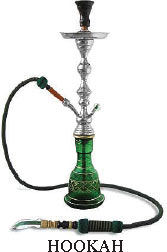January 22-2016

As cigarette smoking declines, more people around the world are smoking tobacco from hookahs—communal pipes that enable users to draw tobacco smoke through water. A new analysis led by the University of Pittsburgh School of Medicine shows that smokers in one hookah session inhale about 25 times as much tar as they get from one cigarette.
Hookahs seem to have taken on a new life in Iran, where they have existed for centuries, and have become popular in recent decades in the United States, where they were previously unknown.
The research findings, published online and scheduled for the January/February print issue of the journal Public Health Reports, represent a meta-analysis, or a mathematical summary of previously published data. The research team reviewed 542 scientific articles potentially relevant to cigarette and hookah smoking and ultimately narrowed them down to 17 studies that included sufficient data to extract reliable estimates on toxicants inhaled when smoking cigarettes or hookahs.
They discovered that, compared with a single cigarette, one hookah session delivers approximately 125 times the smoke, 25 times the tar, 2.5 times the nicotine and 10 times the carbon monoxide.
“Our results show that hookah tobacco smoking poses real health concerns and that it should be monitored more closely than it is currently,” said lead author Dr. Brian A. Primack, assistant vice chancellor for health and society in Pitt’s Schools of the Health Sciences. “For example, hookah smoking was not included in the 2015 Youth Risk Behavior Surveillance Survey System questionnaire, which assessed cigarette smoking, chewing tobacco, electronic cigarettes and many other forms of substance abuse.”
Dr. Primack and his co-authors note that comparing a hookah smoking session to smoking a single cigarette is a complex comparison because of the differences in smoking patterns. A frequent cigarette smoker may smoke 20 cigarettes per day, while a frequent hookah smoker may only participate in a few hookah sessions each day.
“It’s not a perfect comparison because people smoke cigarettes and hookahs in very different ways,” said Dr. Primack. “We had to conduct the analysis this way—comparing a single hookah session to a single cigarette—because that’s the way the underlying studies tend to report findings. So, the estimates we found cannot tell us exactly what is ‘worse.’ But what they do suggest is that hookah smokers are exposed to a lot more toxicants than they probably realize. After we have more fine-grained data about usage frequencies and patterns, we will be able to combine those data with these findings and get a better sense of relative overall toxicant load.”
The US Centers for Disease Control and Prevention recently reported that, for the first time in history, hookah use has exceeded cigarette use among US high school students. About one-third of US college students have smoked tobacco from a hookah, and many of those individuals were not previous users of other forms of tobacco.
In Persian, the hookah is known as the ghalian.
In 2003, the Majlis passed legislation banning the popular pastime after the Ministry of Health cautioned about the health risks associated with the hookah—which officials said then was the equivalent of smoking 20 cigarettes at once. Since then, the law has been enforced erratically and inconsistently around the country.
The hookah is a pipe with a long tube passing through an urn of water, which cools the smoke as it is drawn through.
